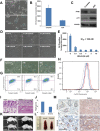EGF promotes mammalian cell growth by suppressing cellular senescence
- PMID: 25367123
- PMCID: PMC4650583
- DOI: 10.1038/cr.2014.141
EGF promotes mammalian cell growth by suppressing cellular senescence
Figures

Similar articles
-
EGFR-blockade with erlotinib reduces EGF and TGF-β2 expression and the actin-cytoskeleton which influences different aspects of cellular migration in lens epithelial cells.Curr Eye Res. 2014 Oct;39(10):1000-12. doi: 10.3109/02713683.2014.888453. Epub 2014 Mar 3. Curr Eye Res. 2014. PMID: 24588338
-
Mucin glycosylating enzyme GALNT2 regulates the malignant character of hepatocellular carcinoma by modifying the EGF receptor.Cancer Res. 2011 Dec 1;71(23):7270-9. doi: 10.1158/0008-5472.CAN-11-1161. Epub 2011 Oct 11. Cancer Res. 2011. PMID: 21990321
-
The antitumor and antiangiogenic activity of vascular endothelial growth factor receptor inhibition is potentiated by ErbB1 blockade.Clin Cancer Res. 2005 Jun 15;11(12):4521-32. doi: 10.1158/1078-0432.CCR-04-1954. Clin Cancer Res. 2005. PMID: 15958638
-
Targeting EGFR activity in blood vessels is sufficient to inhibit tumor growth and is accompanied by an increase in VEGFR-2 dependence in tumor endothelial cells.Microvasc Res. 2008 May;76(1):15-22. doi: 10.1016/j.mvr.2008.01.002. Epub 2008 Mar 18. Microvasc Res. 2008. PMID: 18440031
-
TPN-associated intestinal epithelial cell atrophy is modulated by TLR4/EGF signaling pathways.FASEB J. 2015 Jul;29(7):2943-58. doi: 10.1096/fj.14-269480. Epub 2015 Mar 17. FASEB J. 2015. PMID: 25782989 Free PMC article.
Cited by
-
Branched-Chain Amino Acid Accumulation Fuels the Senescence-Associated Secretory Phenotype.Adv Sci (Weinh). 2024 Jan;11(2):e2303489. doi: 10.1002/advs.202303489. Epub 2023 Nov 15. Adv Sci (Weinh). 2024. PMID: 37964763 Free PMC article.
-
Effects of dietary epidermal growth factor supplementation on liver antioxidant capacity of piglets with intrauterine growth retardation.J Anim Sci. 2023 Jan 3;101:skad323. doi: 10.1093/jas/skad323. J Anim Sci. 2023. PMID: 37812936 Free PMC article.
-
Antagonizing the irreversible thrombomodulin-initiated proteolytic signaling alleviates age-related liver fibrosis via senescent cell killing.Cell Res. 2023 Jul;33(7):516-532. doi: 10.1038/s41422-023-00820-4. Epub 2023 May 11. Cell Res. 2023. PMID: 37169907 Free PMC article.
-
Absence of AMPKα2 accelerates cellular senescence via p16 induction in mouse embryonic fibroblasts.Int J Biochem Cell Biol. 2016 Feb;71:72-80. doi: 10.1016/j.biocel.2015.12.010. Epub 2015 Dec 21. Int J Biochem Cell Biol. 2016. PMID: 26718972 Free PMC article.
-
The landscape of plasma proteomic links to human organ imaging.medRxiv [Preprint]. 2025 Jan 15:2025.01.14.25320532. doi: 10.1101/2025.01.14.25320532. medRxiv. 2025. PMID: 39867388 Free PMC article. Preprint.
References
Publication types
MeSH terms
Substances
Grants and funding
LinkOut - more resources
Full Text Sources
Other Literature Sources

